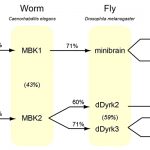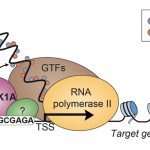Summary
DYRK (dual-specificity tyrosine-regulated kinases) family members are found in four of the five main taxa (Animalia, plantae, fungi and Protista), and all them share common structural and biochemical properties (Figure 1). The mammalian DYRKs (DYRK1A, DYRK1B, DYRK2, DYRK3 and DYRK4) participate in signalling pathways critical for developmental processes and cell homeostasis. In particular, DYRK1A plays a key role in brain development. Both its over-expression, as part of the Down syndrome critical region, as well as its haploinsufficiency (OMIM 614104) are linked to neurodevelopmental alterations in humans. Our group is interested in understanding the biological roles of DYRK kinases, how they are regulated and how their activity impacts on gene regulatory processes.
Progress during 2015 includes the identification of a novel role for class I DYRKs as transcriptional activators. We found DYRK1A associated to the proximal promoter regions of a subset of growth-related genes characterised by the presence of a conserved palindromic motif. The results of biochemical and functional experiments are consistent with DYRK1A being a transcriptional regulator by acting as a RNA polymerase II CTD kinase (Figure 2).
Research projects
Identification of regulatory mechanisms for DYRK kinases activity: allosteric regulation, protein stability, expression.
- Functional characterisation of the nuclear activity of class I DYRKs.
- Identification of chromatin targets of DYRK1A (collaboration with the groups of Stephan Ossowski, CRG, and of Nuria López-Bigas, UPF).
- Characterisation of the molecular mechanism that underlies the activity of DYRK1A as a transcriptional regulator.
- Role of DYRKs as regulators of the activity of the NFAT transcription factors in calcineurin-dependent signalling pathways.
- Role of amino acid repeat expansions in the functional diversification of duplicated transcription factors (collaboration with the group of M. Mar Albà, GRIB).

